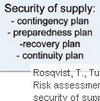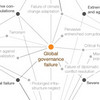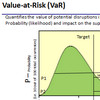 Continuing my previous post, which talked about raising the awareness towards disruption risks in general, today’s post will take a closer look at how to analyze your suppliers for potential disruption risks, and what questions that need to be asked to gain more insight into your supply chain. In essence, this post will provide some starting points for supply chain risk analysis. This the 2nd post in a series that reviews and translates into English some of the content in the book “Säkra företagets flöden” or “Secure the company’s flows” as I have translated it. The book was published in 1999 by the Swedish Emergency Management Agency.
Continuing my previous post, which talked about raising the awareness towards disruption risks in general, today’s post will take a closer look at how to analyze your suppliers for potential disruption risks, and what questions that need to be asked to gain more insight into your supply chain. In essence, this post will provide some starting points for supply chain risk analysis. This the 2nd post in a series that reviews and translates into English some of the content in the book “Säkra företagets flöden” or “Secure the company’s flows” as I have translated it. The book was published in 1999 by the Swedish Emergency Management Agency.
Increased interdependence – thorough analysis
In today’s fast moving world of shifting demands and trends, companies are becoming increasingly dependent on having supplies delivered on time, with the desired quantity and the desired quality. Not only that, companies are becoming increasingly interdependent, whichever disruption that affects one firm in the supply network, may ultimately affect other companies, companies that are maybe not even in the same supply network.
An analysis of disruption risk should thus not focus on just one location or just the company and its immediate suppliers alone. Bottlenecks and weak links exist throughout the whole supply chain, and the key point of a supply chain risk analysis is not to identify and investigate the full spectrum of disruption risk that exist within the intricately woven supply network, but to focus on some of the key spots.
Supply chain risks analysis – starting points
Consequences
The internal consequences of disruptions in supply are relatively easy to assess. However, the impact will depend on the quality demands of the product and the ability to complete the product using other components, or if not, whether the missing component(s) can be assembled at a later stage, with or without delays. The external consequences vis-a-vis the customer are less easy to assess, albeit the marketing and sales department is likely to be a good source of information.
Probability
The probability of a disruption in supply is important in assessing what impact a disruption will have. This implies assessing not only the supplier alone, but also the suppliers environment, his access to sub-suppliers, raw materials, personnel, and other factors that may lead to a disruption from that particular supplier.
Value of contribution
The particular value a particular supplier adds to the final product is important in assessing how valuable the supplier is. It is more likely to find a replacement for low-value high-volume components than it is for high-value low-volume components, although this may not always hold true. Holding a buffer inventory is cheaper for mass components than for selected items of high value. It may sound cynical, but the less value a supplier adds, the more disposable he becomes.
Technology
If a supplier uses more advanced technology than his competitors it may be hard to find a replacement supplier, and, at the same time, relying on that one (advanced) supplier can be risky, despite the competitive advantage of using state-of-the-art technology.
Contracts
The contractual terms and conditions with suppliers are important in defining how supply chain disruption are handled and who has to pay for delays or non-delivery.
Intellectual property
Securing the intellectual rights to processes and patents not only related to your own company, but also supplier processes, is essential to business continuity. This also includes a backup for drawings, prototypes, tools, machines and other equipment that can may take a long time to replace, should disaster or disruption strike.
Supplier flexibility
How flexible and adaptable are your suppliers? A supplier with several independent production facilities is more likely to be able to shift production to a different location if there is a disruption at one location. A supplier with only one facility can be a high-risk undertaking and should be avoided.
Mutual interest
Both you and your suppliers have a mutual interest in continuing the relationship. If your company is an important customer with a supplier, ideally both parties should have the same view on the importance of disruptions. To a supplier, losing a major customer is as serious as losin a strategic supplier would be to a company.
Promise to deliver
Your supplier may promise to deliver, but is he actually able – and willing – to do so when the going gets tough? Is your company given priority, or are you just one of many customers? Does the supplier have a history of not keeping up to his promises or selectively choosing to work with his major customer rather than a minor customer who is in dire need?
Replacements and alternatives
If there is a disruption with one of your suppliers, it is likely that this will also affect other companies, who too will seek replacements. How successful do you think your company will be in securing these alternatives. Will there be enough supply, or should other (not so highly sought after) alternatives be considered?
Do your homework
These are just some of the issues a company faces when analyzing supply chain disruptions. It may seem overwhelming at first, but remember, not all risks and not all possible events are equally important. Asking these questions is only the second step towards lessing the impact of supply chain disruptions.
In my next post I will look at a checklist that will assist you in sorting disruptions into important and not so important events.
Reference
Giertz, E., et al. (1999) Säkra företagets flöden, Silfgruppen, Stockholm. ISBN 91 7097 056-4
Related
- husdal.com: How to secure your supply chain – 1/7
- husdal.com: How to secure your supply chain – 2/7
- husdal.com: How to secure your supply chain – 3/7
- husdal.com: How to secure your supply chain – 4/7
- husdal.com: How to secure your supply chain – 5/7
- husdal.com: How to secure your supply chain – 6/7
- husdal.com: How to secure your supply chain – 7/7












